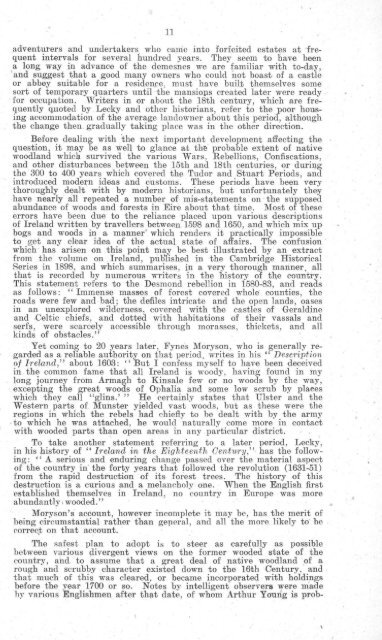Download Full PDF - 19.3 MB - The Society of Irish Foresters
Download Full PDF - 19.3 MB - The Society of Irish Foresters
Download Full PDF - 19.3 MB - The Society of Irish Foresters
You also want an ePaper? Increase the reach of your titles
YUMPU automatically turns print PDFs into web optimized ePapers that Google loves.
11<br />
adventurers and undertakers who came into forfeited estates at frequent<br />
intervals for several hundred years. <strong>The</strong>y seem to have been<br />
a long way in advance <strong>of</strong> the demesnes we are familiar with to-day,<br />
'and suggest that a good many owners who could not boast· <strong>of</strong> a castle<br />
or abbey suitable for a residen,::e, must have built themselves some<br />
sort <strong>of</strong> temporary quarters until the mansio!ls created later were ready<br />
for occupatlOn. ';Vriters in or about the 18th century, which are frequently<br />
qnoted by Lecky and other historians, r efer to the 'pOOl' housing<br />
accommodation <strong>of</strong> the average landowner about this period, although<br />
the change then gradually taking place was in the other direction.<br />
Before dealing with the next important development affecting the<br />
question it may be as well to glance at th~ probable extent <strong>of</strong> native<br />
woodland whic4 survived the various 'Var:;, Rebellions, Confiscations,<br />
and other disturbances between the 15th and 18th centuries, or during<br />
the 300 to 400 years which covered the Tudor and Stuart Periods, and<br />
introduced model,"n ideas and customs. <strong>The</strong>se periods have been very<br />
thoroughly dealt with by modern historians, but unfortunately they<br />
have nearly all repeated a number <strong>of</strong> mis-statements on the supposed<br />
abundance <strong>of</strong> woods and forests in Eire about that time. Most <strong>of</strong> these<br />
errors have been due to the reliance plaoed upon various descriptions<br />
<strong>of</strong> Ireland written by travellers between. 1598 and 1650, and which mix up<br />
bogs and woods in a manner which renders it practically impossible<br />
to get any clear idea <strong>of</strong> the actual state <strong>of</strong> affairs. <strong>The</strong> confusion<br />
which has arisen on this point may be best illustrated by an extract<br />
from the volume on . Ireland, puOlished in the Cambridge Historical<br />
Series in 1898, and which summarises, in a very thorough manner, all<br />
that is recorded by numerous writers in the history <strong>of</strong> the country.<br />
This statement refers to the Desmond rebellion in 1580-83, and reads<br />
as follows : "Immense masses <strong>of</strong> forest covered whole counties, the<br />
roads were few and bad ; the defiles intricate and the open lands, oases<br />
in an unexplored wilderness, covered with the castles <strong>of</strong> Geraldine<br />
a,nd Celtic chiefs, and dotted with habitations <strong>of</strong> their vassals and<br />
serfs, were scarcely accessible through morasses, thickets, and all<br />
kinds <strong>of</strong> obstacles."<br />
Yet coming to 20 years later, Fynes Moryson, who is generally regarded<br />
as a reliable authority on that period. writes in his " Description<br />
<strong>of</strong> Ireland," about 1603: "But I confess myself to have been deceived<br />
in the common fame that all Ireland is woody, having found in my<br />
long journey from Armagh to Kinsale few or no woods by the way,<br />
excepting the great woods <strong>of</strong> Ophalia and some low scrub by plaees<br />
which they call "glins.'" He certainly states that Ulster and the<br />
Western parts <strong>of</strong> Munster yielded vast woods, but as thes'e were the<br />
regions in which the rebels had chiefly to be dealt with by the army<br />
to which he was attaohed, he would naturally come more in (lontact<br />
with wooded parts than open areas in any particular district.<br />
To take another statement referring to a later period, Lecky,<br />
in his history <strong>of</strong> " Ireland in the Eighteenth Cenftlirll,"· has the following:<br />
., A serious and enduring change passed over the material aspect<br />
<strong>of</strong> the country in the forty years that followed the revolution (1631-51)<br />
hom the rapid destruction <strong>of</strong> its forest trees. <strong>The</strong> history <strong>of</strong> this<br />
destruction is a curious and a melancholy one. When the English first<br />
established themselves in Ireland, no country in Europe was more<br />
abundantly \ wooded."<br />
Moryson's account, however incomplete it may be, has the merit <strong>of</strong><br />
being circumstantial rather than gep.eral, and all the more likely to' be<br />
correc,t on tha.t account.<br />
<strong>The</strong> safest plan to adopt is to steer as carefully as possible<br />
between various 9.ivergent views on the former wooded state <strong>of</strong> the<br />
country, and to assume that a great dea.l <strong>of</strong> native woodland <strong>of</strong> a<br />
rough a.nd scrubby character existed down to the 16th Century, and<br />
that mueh <strong>of</strong> this was cleared, or became incorporated with holdings<br />
before the year 1700 or so. Notes by intelligent observers were made<br />
by various Englishmen after thltt date, <strong>of</strong> whom Arthur Young is prob-

















